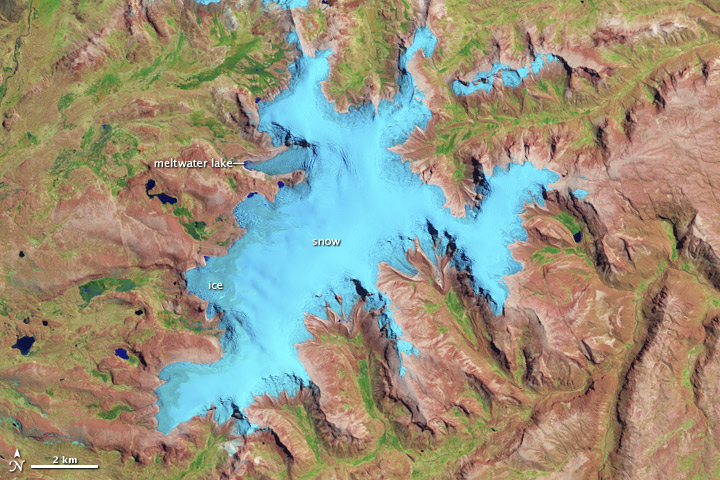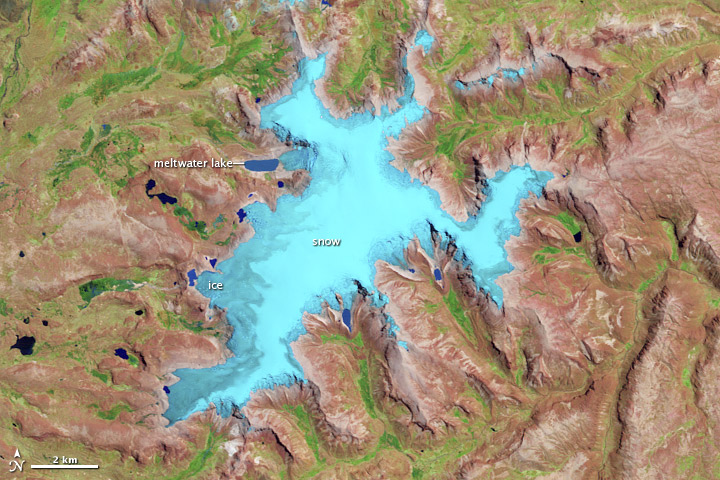NASA: Peru - Tropical Climate History...Shrinking - 08.05.13
Posted by Ricardo Marcenaro | Posted in NASA: Peru - Tropical Climate History...Shrinking - 08.05.13 | Posted on 21:12

acquired September 3, 1988
download large image (5 MB, JPEG, 3997x2664)
acquired September 16, 2010
download GeoTIFF file (93 MB, TIFF)

acquired September 3, 1988
download large image (5 MB, JPEG, 3997x2664)
acquired September 16, 2010
download GeoTIFF file (23 MB, TIFF)
Glaciers and ice caps
grow through the long-term accumulation and compression of snow, and
these monstrous blocks of ice usually respond slowly to changes in
Earth’s climate. This can make them excellent recorders of climate
changes. But when they recede quickly, they can also become potent
symbols of warming trends in the wider world.
The Quelccaya Ice Cap in Peru is rare for several reasons. Situated
at 13.5 degrees South latitude, it lies between the Tropic of Capricorn
and the Equator, and it is the world’s largest tropical ice cap. This
collection of glaciers grows on a high-altitude plateau in the Andes
Mountains, between the Amazon jungle to the east and tropical, eastern
Pacific waters to the west. Because of its location, the ice cap
captures chemical signatures of the cycles of El Niño and La Niña. Those
signatures from the atmosphere are locked in ice cores that Lonnie Thompson and colleagues from Ohio State University
have drilled from Quelccaya, and they provide nearly year-by-year
records of temperatures and atmospheric composition dating back 1,800
years.
Based on field and laboratory work by Thompson’s team—as well as three decades of satellite imagery—scientists also know that Quelccaya has been shrinking rapidly. The Thematic Mapper on the Landsat 5
satellite captured these images of Quelccaya on September 3, 1988 (top)
and September 16, 2010 (bottom). Both images use a combination of
visible, near-infrared, and shortwave infrared light. Brick-colored land
around the glacier is largely barren. Green patches indicate
vegetation, mostly wetlands known as bofedales.
Snow and ice appear in shades of light blue or cyan. The difference
between snow and ice is subtle, but snow is slightly lighter. Liquid
water appears blue, but not all ponds and lakes are the same shade of
blue. Meltwater lakes along the margins of the ice are typically lighter
due to glacial flour—fine particles produced by the grinding movement of the ice over bedrock.
The biggest meltwater lake in the image lies at the end of the Qori
Kalis glacier in the northwestern half of the ice cap. Between 1988 and
2010, the lake grew as Qori Kalis shrank. Over the same period, other
meltwater lakes grew around the margins of the ice cap. “There appear to
be eight lakes that have formed since the 1988 image was acquired,”
noted Thompson.
The retreat of this Andean ice cap has done more than fill meltwater
lakes; it has exposed ancient plants that were effectively frozen in
time and place as the glacier advanced. As the glaciers have retreated
in recent decades, the plants have provided clues as to how long the ice
had been there. Radiocarbon dating
has enabled Thompson and colleagues to estimate that plants collected
on the edges of meltwater lakes over the past decade were between 4,700
and 6,300 years old.
In recently published research,
Thompson and colleagues note: “Quelccaya is now smaller than it was
6,000 years ago. Moreover, the plant ages confirm that the advance of
the Quelccaya Ice Cap about 6,000 years ago was much slower—about 300
meters over 1,600 years—than its current rate of retreat of about 300
meters in 25 years.”
References
- Gillis, J. (2013, April 4) In sign of warming, 1,600 years of ice in Andes melted in 25 years. The New York Times. Accessed April 29, 2013.
- Ohio State University (2013, April 4) Discovery of 1,800 year old Rosetta Stone for Tropical Ice Cores. Accessed April 29, 2013.
- Thompson, L.G., Mosley-Thompson, E., Davis, M.E. Zagorodnov, V.S., Howat, I.M., Mikhalenko, V.N., Lin, P.-N. (2013) Annually resolved ice core records of tropical climate variability over the past ~1800 years. Science, published online April 4, 2013.
NASA Earth Observatory image by Robert Simmon, using Landsat data from the U.S. Geological Survey.
Caption by Michon Scott and Mike Carlowicz, with information from Dan
Slayback and Dorothy Hall, NASA Goddard Space Flight Center, and Lonnie
Thompson, Byrd Polar Research Center.
- Instrument:
- Landsat 5 - TM
NASA: Peru - Tropical Climate History...Shrinking - 08.05.13
Ricardo Marcenaro
Sculptures – Esculturas
http://ricardomarcenaro.ning.com/
Ricardo M Marcenaro - Facebook
Blogs in operation of The Solitary Dog:
Solitary Dog Sculptor:
http://byricardomarcenaro.blogspot.com
Solitary Dog Sculptor I:
http://byricardomarcenaroi.blogspot.com
Para:
comunicarse conmigo,
enviar materiales para publicar,
propuestas comerciales:
marcenaroescultor@gmail.com
For:
contact me,
submit materials for publication,
commercial proposals:
marcenaroescultor@gmail.com
Diario La Nación
Argentina
Cuenta Comentarista en el Foro:
Capiscum
My blogs are an open house to all cultures, religions and countries. Be a follower if you like it, with this action you are building a new culture of tolerance, open mind and heart for peace, love and human respect.
Thanks :)
Mis blogs son una casa abierta a todas las culturas, religiones y países. Se un seguidor si quieres, con esta acción usted está construyendo una nueva cultura de la tolerancia, la mente y el corazón abiertos para la paz, el amor y el respeto humano.
Gracias :)


Comments (0)
Publicar un comentario